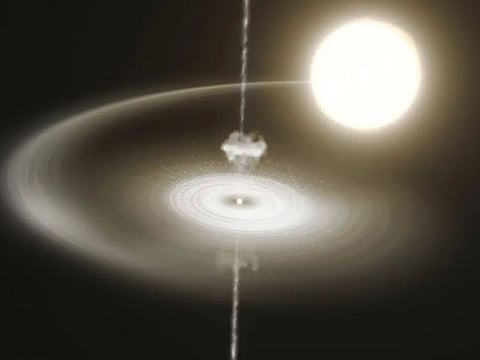UAE: Puzzle of ‘bizarre’ pulsar star unravelled by researchers in Abu Dhabi
International effort with 12 telescopes on ground, in space detected strange cosmic events

Abu Dhabi: NYU Abu Dhabi (NYUAD) researchers are part of a team of astronomers that have uncovered the strange behaviour of a millisecond pulsar, a super-fast-spinning dead star. The discovery followed an observational campaign that involved 12 telescopes both on the ground and in space.
This mysterious pulsar is known to switch between two brightness modes almost constantly, something that until now has been an enigma. But astronomers have now found that sudden ejections of matter from the pulsar over very short periods are responsible for the peculiar switches.
“We have witnessed extraordinary cosmic events where enormous amounts of matter, similar to cosmic cannonballs, are launched into space within a very brief time span of tens of seconds from a small, dense celestial object rotating at incredibly high speeds,” said Maria Cristina Baglio, researcher at NYUAD, affiliated with the Italian National Institute for Astrophysics (INAF), and the lead author of the paper published in Astronomy and Astrophysics.
What is a pulsar?
A pulsar is a rapidly rotating magnetic dead star that emits a beam of electromagnetic radiation into space. As it rotates, this beam sweeps across the cosmos — much like a lighthouse beam scanning its surroundings — and is detected by astronomers as it intersects the line of sight to Earth. This makes the star appear to pulse in brightness as seen from our planet.
'Bizarre behaviour'
PSR J1023+0038, or J1023 for short, is a special type of pulsar with bizarre behaviour. Located about 4,500 light-years away in the Sextans constellation, it closely orbits another star. Over the past decade, the pulsar has been actively pulling matter off this companion, which accumulates in a disc around the pulsar and slowly falls towards it.
Since this process of accumulating matter began, the sweeping beam vanished, and the pulsar started incessantly switching between two modes. In the ‘high’ mode, the pulsar gives off bright X-rays, ultraviolet and visible light, while in the ‘low’ mode this light is dimmer, it emits radio waves. The pulsar can stay in each mode for several seconds or minutes, and then switch to the other mode in just a few seconds. This switching has thus far puzzled astronomers.
Massive undertaking
The campaign included four X-ray satellites and the Hubble Space Telescope in space, and five telescopes on the Earth collecting radio waves, microwaves, infrared and optical light. Over two nights in June 2021, they observed the system make over 280 switches between its high and low modes.
“We have discovered that the mode switching stems from an intricate interplay between the pulsar wind, a flow of high-energy particles blowing away from the pulsar, and matter flowing towards the pulsar,” said Francesco Coti Zelati, researcher at the Institute of Space Sciences, Barcelona, Spain.
In the low mode, matter flowing towards the pulsar is expelled in a narrow jet perpendicular to the disc. Gradually, this matter accumulates closer and closer to the pulsar and, as this happens, it is hit by the wind blowing from the pulsating star, causing a shock which emits radiation at optical, UV and X-ray wavelengths.
The system is now in a high mode, glowing brightly in the X-ray, ultraviolet and visible light. Eventually, blobs of this hot matter are removed by the system via the jet, producing very short-duration flares at microwave wavelengths. With less matter close to the pulsar, the pulsar wind cannot intersect the disc anymore, resulting in a fainter emission, and switching back into the low mode.
“When I first saw these brief flashes of microwaves in the data, I immediately thought ‘Hey, that looks like a jet ejection’, and we realised we were witnessing blasts of material radiating in microwaves and radio waves as the jet travels away from the pulsar," said NYUAD Associate Professor of Physics David Russell.
Wider impact
These results could be used to predict the behavior of transitional pulsars based on their observed properties, providing valuable insights into the formation and evolution of these fascinating objects.
“They are of the utmost importance for the study of the physics of accretion, the most energetic process in the universe”, said Kevin Alabarta, Post-doctoral associate at NYUAD. Moreover, “they could lead to the development of new observational techniques and methods for studying outflow mechanisms and the role of accretion in the evolution of compact objects”, said Payaswini Saikia, Post-doctoral associate at NYUAD.
Sign up for the Daily Briefing
Get the latest news and updates straight to your inbox








